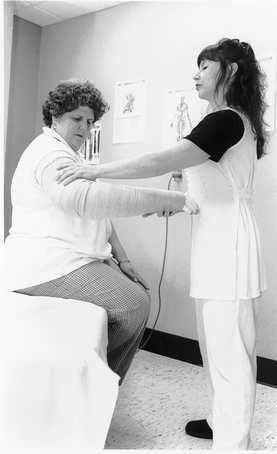
Massage therapist Sharon Tibbits performs Manual Lymphatic Drainage therapy on patient Mary Ann Connell
Therapy eases swelling due to lymphedema
A new therapy technique at Vanderbilt University Medical Center is helping patients deal with lymphedema, the swelling of limbs due to a buildup of lymph fluid in the tissues.
The Manual Lymphatic Drainage (MLD) therapy program, one of only a few available in the United States, has been under way at Vanderbilt Stallworth Rehabilitation Hospital for about nine months.
An outpatient physical therapy program, the treatment involves a specialized manual technique to get the affected limb back to normal size.
"It is really working well," said Sharon Tibbits, licensed massage therapist at Vanderbilt Stallworth Rehabilitation Hospital. "We have seen some remarkable improvements in many patients. I am just very excited that we can offer Manual Lymphatic Drainage to our patients,"
"The lymph system is responsible for the removal of plasma proteins, metabolic wastes, excess water and other foreign substances from within the body," Tibbits says.
"When lymph nodes have been removed or damaged by radiation or surgery, they can no longer remove the body cell waste and the fluid builds up in the arms, trunk or the legs of patients."
Lymphedema ranges from a slight swelling of the limb to severe swelling, called lymphostatic elephantitis.
"When a person first gets lymphedema, it is just swelling. As it progresses, it becomes very heavy and very large. There is not generally pain associated with it, but people do sometimes have pain, mostly with joint mobilization, due to an excess of fluid buildup around the joint capsule," Tibbits says.
"MLD has been done in Europe for decades. It just came to the United States six or seven years ago."
The treatment consists of two major components, Tibbits says.
"First we start with MLD, which is a very gentle manual treatment technique designed to enhance the flow of lymph fluid through the body and to restore the lymph system. The excess fluid is moved through the body and emptied into the venous system via the thoracic duct.
"The second part of the treatment is compression wrapping. After the hands-on technique, the patient is wrapped in a series of compression bandages to keep the fluid from accumulating again. It increases the tissue pressure," Tibbits said.
Tibbits says the MLD takes from 25-40 minutes. Most patients, she says, are treated daily for up to six weeks, depending on the stage of lymphedema.
Tibbits cautions that lymphedema is a lifelong disease and MLD is not a cure. It only alleviates the symptoms, but she says there have been some remarkable improvements in the 30 patients who have already undergone treatment.
"With proper care and compliance with a home exercise program and the daily use of a compression garment, patients can maintain their volume reduction long-term," Tibbits said.
Pat Seman developed lymphedema in her leg four years ago. She used a compression pump, but it didn't help the swelling.
Then, six months ago, a relative told her about MLD.
"It worked in a week. I could see a difference," Seman said. "I saw results right away, which was especially surprising because I had had the lymphedema in my leg for so long. I am just thrilled with the progress I have made."
Seman says her leg size has gone down 80 percent.
"It's fantastic. I'll be coming one day a week probably for the rest of my life, but it's livable now. I can wear normal clothes and I feel so much better about myself."
Peg Tolman developed lymphedema in her arm about eight weeks after a mastectomy and the removal of her armpit lymph nodes.
"My surgical procedure seemed to heal well and I was doing exercises and had no particular pain or anything, but I awoke one morning with my arm and hand swollen," Tolman said.
"The doctor suggested I might use a compression pump for an hour a day to deal with the swelling. I did that, but within two hours, it would return and sometimes the swelling would be as great or greater than before."
Now Peg says her arm is back to its regular size.
"The swelling is less obvious and the arm is more attractive and it feels more comfortable than it did before when it was swollen."
To receive the treatment, patients must have a doctor's prescription. Tibbits says most insurance companies cover the treatment.













